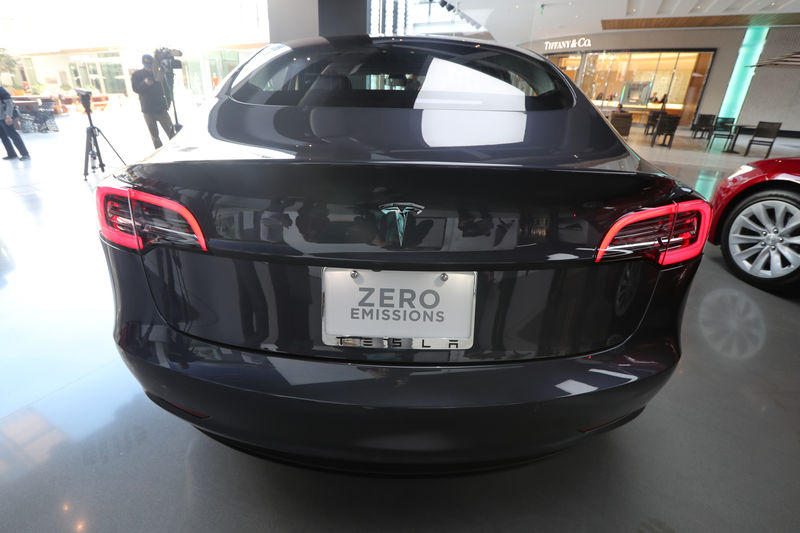This post was originally published on this site
https://i-invdn-com.investing.com/trkd-images/LYNXMPEJ0P049_L.jpg
(Reuters) – Elon Musk has a playbook for Tesla (NASDAQ:TSLA) headed into what he believes will be a “serious” recession: cut costs on everything from parts to logistics, while keeping the pressure on competitors with discounted sticker prices.
In a conference call to discuss Tesla’s fourth-quarter results, Musk and other executives outlined plans to reshape the electric vehicle (EV) maker’s cost base after slashing prices up to 20%, a move some analysts see as the first shot in a price war.
Part of the plan is expanding production at Tesla’s newest plants in Berlin and Austin, Texas and increasing the company’s in-house production of batteries, since scale yields savings, executives said.
But Chief Financial Officer Zachary Kirkhorn said the company would also be “attacking every other area of cost and unwinding cost increases created for multiple years of COVID-related instability.”
That would mean running Tesla factories leaner with fewer materials in inventory, cutting shipping and logistics costs and negotiating lower prices for components, he said – putting Tesla’s suppliers like on notice.
Among its suppliers, Tesla buys batteries from Japan’s Panasonic (OTC:PCRFY) and China’s CATL, and sources the massive presses it has used to take cost and complexity out of production from Italy’s IDRA Group.
Tesla is also cutting costs by redesigning elements of battery and electric motor systems, removing features that owners are not using, based on data collected from Model 3 sedans and Model Y SUVs on the road, the company said.
Bill Russo, founder of China-based consultancy Automobility, said Tesla had already made gains on cost competitiveness by driving simplified hardware designs for its electric vehicles, taking a page from consumer electronics manufacturers.
“You can offset some of the margin hit from pricing with massive scale and simpler electronic architecture,” Russo said. “This is how they are trying to win the game.
Meanwhile the cost of lithium in EV batteries – the single most expensive component – will be higher in 2023 than last year, Kirkhorn said, a pressure that will hit Tesla’s rivals that are still losing money on EVs harder.
“My guess is if the recession is a serious one, and I think it probably will be but I hope it isn’t, that would lead to meaningful decrease in almost all of our input costs,” Musk said. “So we expect to see deflation in our input costs, which would likely then lead to, yes, better margin.”
PROFITABILITY KEY
Tesla said on Tuesday it would invest more than $3.6 billion to expand its Nevada factory complex and to increase the output of battery cells so that it could produce enough there to power 2 million vehicles annually.
Tesla forecast it would sell 1.8 million EVs this year, which would mean sales growth of about 37%. That annual number could be as high as 2 million vehicles barring an external shock, Musk said.
Tesla made an average profit of almost $9,100 per vehicle sold in the fourth quarter, down 6% from a quarter earlier but still far more than established competitors. Tesla’s third-quarter profit per car sold was more than seven times higher than Toyota Motor (NYSE:TM) Corp, for example.
Tesla slashed prices by as much as 20% earlier this month, a move that broadened the range of its line-up that qualifies for tax credits of $7,500 per vehicle in the United States.
But analysts have focused on how well Tesla can sustain a core measure of profitability, the gross margin on auto sales, excluding credits.
Kirkhorn said Tesla expected to see that metric above 20% for 2023 with the average price of its vehicles above $47,000 even after discounts. By comparison, the average price of a new vehicle was just over $49,500 in the U.S. market in December, according to Kelley Blue Book.
Bringing costs down is also key to the next phase of Tesla’s expansion, which Musk hinted the company would detail at its investor day in March: plans for an affordable EV that analysts have expected to be priced below $35,000.
Tesla is also planning to roll out a revamped version of the Model 3 sedan later this year code-named “Highland” with a focus in part on reduced production cost, Reuters has reported.
The company’s average cost per vehicle, including all categories of its spending, was almost $44,000 in the fourth quarter.
“Price really matters. I think there’s just a vast number of people that want to buy a Tesla but can’t afford it,” Musk said.

